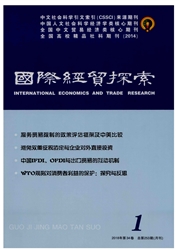

 中文摘要:
中文摘要:
考察2008~2009年金融危机爆发期间美国劳动生产率变化情况,发现美国的劳动生产率强烈地表现出反周期现象。为分析这一现象的成因,从总劳动投入视角切入,将总劳动投入分解为劳动数量和劳动质量,建立影响劳动生产率变化的时间序列模型,并利用美国2008~2009年季度相关数据进行实证检验。研究结果表明,劳动数量与劳动质量对劳动生产率变化存在相反方向的作用,其中,劳动数量的作用占据主导,进而我们认为,美国劳动生产率表现出反周期现象是由总劳动投入数量的大幅减少导致。这一发现对于新常态下的中国稳就业、保增长和推进经济转型升级等具有重要启示意义。
 英文摘要:
英文摘要:
Observing the labor productivity of America during the 2008-2009 financial crisis, the paper finds that there exists a counter-cyclical phenomenon that the total GDP output declines dramatically while the labor productivity continually rises. In order to analyze the causes of this phenomenon, this paper divides the total labor input into labor quantity and labor quality, and establishes a time-series model to analyze the labor productivity. Additionally, it uses the American quarterly economic data from 2008 to 2009 to have an empirical test. It finds that: labor quantity and labor quality affect the change of productivity in an opposite direction, and the former plays a dominant role, and the counter-cyclical phenomenon of American labor productivity is caused by the significant decline of total labor input quantity. This finding has an important enlightenment for China to achieve the goals of ensuring steady employment, growth and transformation and upgrading in the "new normal economy".
 同期刊论文项目
同期刊论文项目
 同项目期刊论文
同项目期刊论文
 期刊信息
期刊信息
